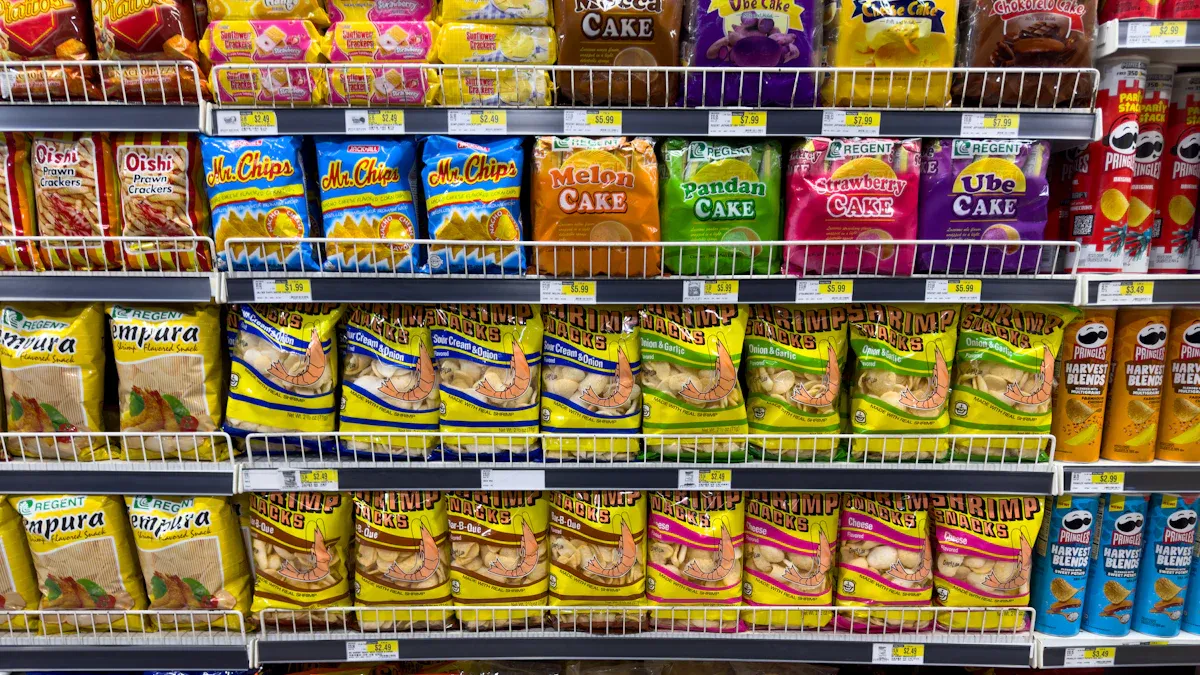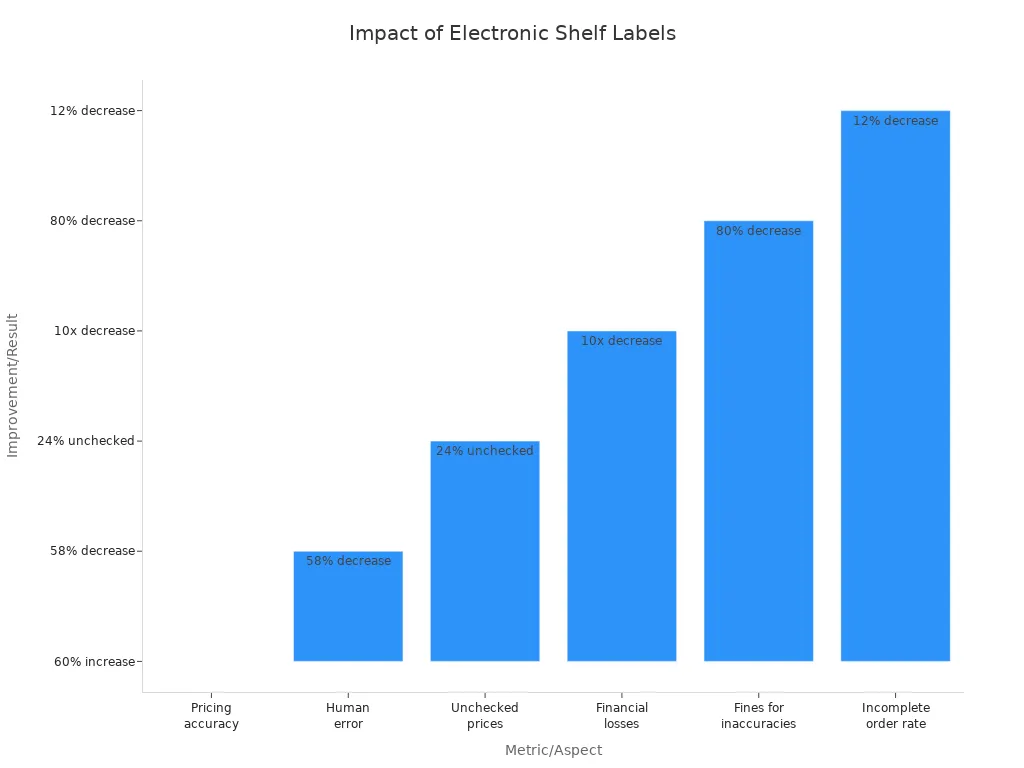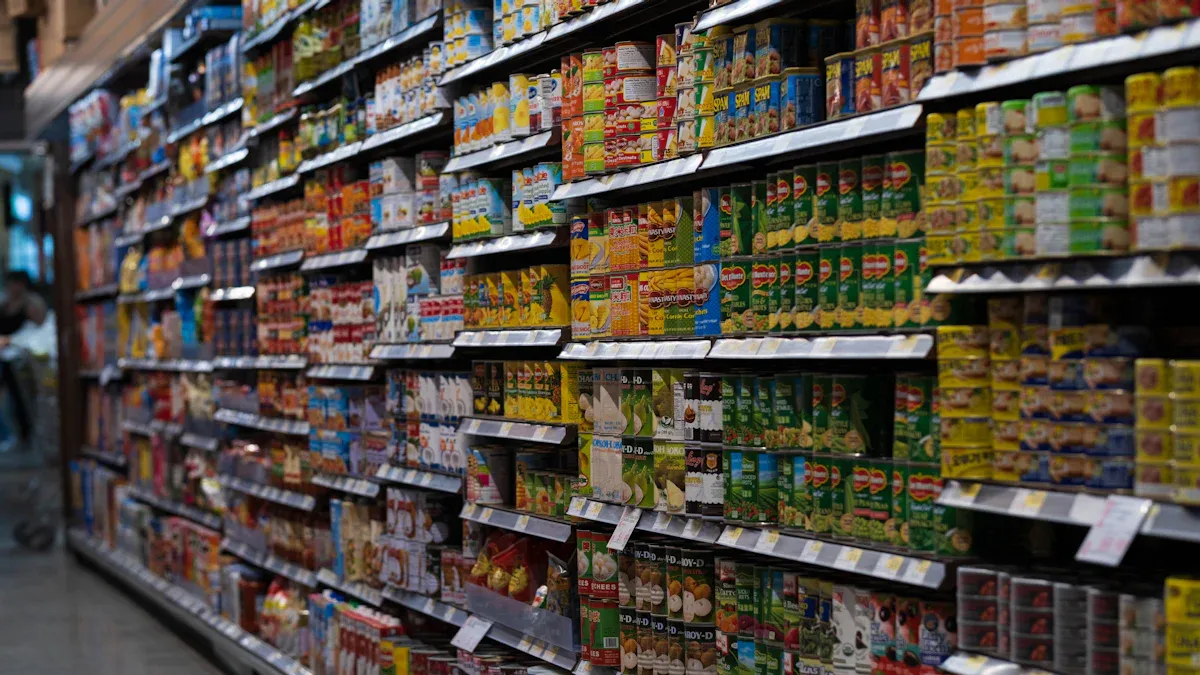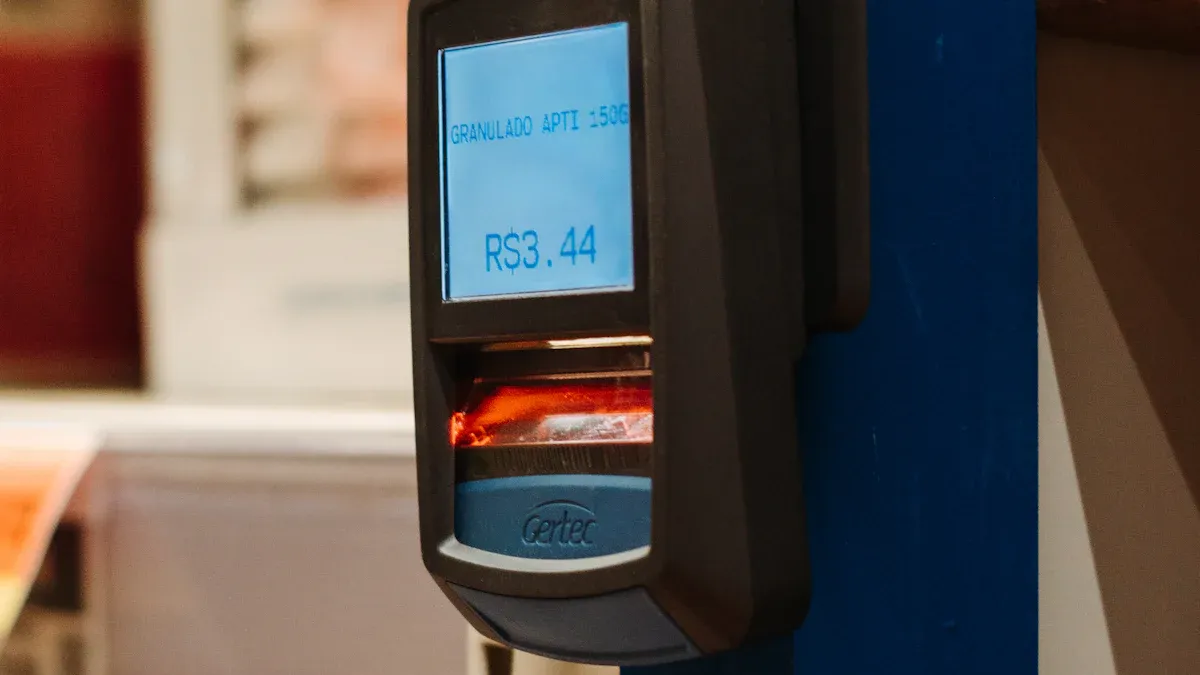
You can transform your store’s pricing accuracy with electronic shelf labels. When you automate updates using ESL Gateway AP and ESL Price Tag, you cut human error and save time. Esl Retail technology ensures shelf prices always match the register. Retailers report a 60% increase in pricing accuracy and a 58% drop in pricing mistakes after implementing electronic shelf labels.
| Metric | Improvement/Result |
|---|---|
| Increase in pricing accuracy | 60% |
| Reduction in human error | 58% |
| Error-related financial losses | 10x decrease |

Pricing Mistakes and Accuracy Challenges with Traditional Labels

Manual Updates and Human Error
Mistakes During Price Changes
You face significant risks when relying on manual price updates. Employees often make entry errors, especially during busy periods. Typos, misplaced decimals, and incorrect price overrides at checkout can slip through unnoticed. Staff under pressure may use placeholder prices instead of accurate ones. Miscommunication about in-store promotions leads to inconsistent pricing. Outdated or mismatched price tags appear when employees forget to update or remove old tags. Multiple clearance stickers on a single item create confusion and mismatches at checkout. Failure to update tags after markdowns remains a common source of error. These mistakes can result in unexpected savings for shoppers who notice them.
Pro Tip: Always check your receipt before leaving the store. Take a photo of the shelf label to confirm the price at checkout.
Misplaced or Overlooked Labels
You may encounter misplaced or overlooked labels, which disrupt the shopping experience. Employees sometimes miss updating a tag or place it in the wrong spot. This oversight causes confusion for both staff and customers. Outdated sale prices and misplaced tags frustrate shoppers and reduce sales. Correcting these errors requires additional staff time, adding hidden costs to your operations.
- Traditional shelf labeling increases operational costs due to labor-intensive manual price updates, costing a mid-sized store over $10,000 annually in staff time.
- Manual processes are prone to human error, resulting in mislabeled items and outdated sale prices.
- Pricing mistakes force you into unplanned markdowns, eroding profits.
Operational Pressures in Retail
Rushed Updates During Promotions
Retail environments move quickly, especially during promotions. You must adjust prices on many products at once, often with little notice. The complexity and rapid pace of these changes make it difficult to maintain accuracy. Daily price changes can seem random and confusing, especially without a clear strategy. This challenge grows when you need to respond to market shifts or competitor pricing.
Inconsistent Labeling Across Locations
If you manage multiple stores, you know how hard it is to keep pricing consistent. Operational pressures, such as rising costs for shipping, labor, and digital advertising, add complexity. Third-party vendors and logistics services introduce more variables. Retail theft, both internal and external, disrupts inventory accuracy and inflates costs. These factors make it difficult to maintain uniform pricing and clear communication across all locations.
Impact on Business and Customers
Customer Confusion and Complaints
Pricing mistakes create confusion and frustration for your customers. Shoppers may see multiple prices for the same item or find that the shelf price does not match the register. This inconsistency erodes trust and leads to complaints. Customers may doubt product quality if prices seem too low or feel alienated if prices are too high.
Lost Revenue and Compliance Risks
You risk losing revenue and facing compliance issues when pricing mistakes occur. Inconsistent or unclear pricing strategies damage customer loyalty and complicate financial forecasting. Frequent discounting and “fake” sales can harm your brand and reduce profit margins. Poor demand forecasting may result in missed revenue or lost customers. Overemphasis on sales volume without considering profit margins can lead to misguided decisions that hurt your bottom line. Customer feedback and sales patterns often reveal these mistakes, signaling the need for better pricing accuracy.
How Electronic Shelf Labels Improve Pricing Accuracy

Automated Price Updates and Synchronization
Centralized Control and Real-Time Changes
You gain full control over pricing with electronic shelf labels. Centralized management allows you to update prices across every shelf in real time, whether you operate a single store or a nationwide chain. You no longer wait for manual changes or risk delays caused by printing and placing paper tags. With remote updates, you push new prices instantly from your POS or head office system. This process ensures that every shelf reflects the correct price at all times.
Note: Centralized control means you can respond quickly to market changes, competitor pricing, or inventory shifts without relying on manual labor.
Traditional paper-based pricing often causes delays of at least 24 hours and inconsistencies across locations. Electronic shelf labels use wireless communication to synchronize prices instantly, guaranteeing that shelf prices always match checkout prices. Compliance reports confirm this match, reducing errors and improving pricing consistency.
Seamless Integration with POS Systems
You benefit from seamless integration between electronic shelf labels and your POS systems. Modern ESLs connect through APIs or middleware, enabling real-time synchronization of pricing data. This integration ensures that prices on shelves and at checkout remain accurate, eliminating discrepancies and customer disputes.
- ESLs link with POS and inventory software for consistent, real-time pricing updates.
- Automated price updates eliminate manual errors by instantly updating prices across all locations from a centralized dashboard.
- Integration supports dynamic pricing strategies, allowing you to adjust prices in real time based on demand or promotions.
You can implement complex pricing strategies and promotions with confidence, knowing that every label reflects the latest price. Compatibility checks and middleware solutions ensure that even legacy POS systems can support ESL integration.
Reducing Human Error with Technology
Elimination of Manual Label Changes
You remove the risk of manual mistakes by automating price updates. Electronic shelf labels synchronize automatically with your POS system, updating prices in real time. This automation prevents errors caused by manual entry, mislabeling, or missed changes. You no longer need to print, distribute, and replace paper tags, saving thousands of labor hours each year.
- Manual price tag updates consume over 50 hours weekly and are prone to human error.
- Electronic price tags automate updates, reducing labor costs by up to 90% and shortening full-store repricing from weeks to minutes.
Wireless communication technologies, such as radio or infrared, enable instant updates and reduce the need for manual intervention. You can correct rare errors across all locations from a central point, ensuring consistent price accuracy.
Consistent Pricing Across All Shelves
You achieve consistent pricing across every shelf and store location. Real-time synchronization ensures that prices reflect promotions and changes instantly. You eliminate discrepancies between shelf and checkout prices, building customer trust and reducing complaints.
- ESLs wirelessly connect shelves to pricing engines, allowing instant, synchronized price updates across multiple labels.
- Dynamic pricing and promotion pushes are automated, improving accuracy and responsiveness to market conditions.
Color coding and data display features help you identify stock issues and respond promptly, further reducing errors related to inventory management and pricing.
Data-Driven Accuracy Improvements
Error Reduction Statistics
You see measurable improvements in pricing accuracy after adopting electronic shelf labels. The following table highlights key metrics reported by retailers:
| Improvement Metric | Data/Result | Impact/Benefit |
|---|---|---|
| Price Accuracy | 100% price accuracy ensured | Eliminates mismatches between shelf and checkout prices, reducing compliance risks and customer frustration |
| Pricing Errors | 50% reduction (Carrefour case study) | Fewer pricing mistakes, improving operational accuracy and customer trust |
| Label Maintenance Time | 80% reduction | Saves labor and operational costs, enabling faster price updates |
| Dynamic Pricing | Real-time adjustments via AI-powered algorithms | Enables responsive pricing based on demand, competitor pricing, and inventory, optimizing margins |
| Customer Satisfaction | Improved (reported by Carrefour) | Enhances shopping experience and loyalty |
| Operational Efficiency | Increased | Faster turnover, better employee productivity, and higher profit margins |
You can expect instant price updates from a central system, minimizing manual errors and ensuring accurate pricing in real time. Label management costs drop by up to 50%, and promotion frequency increases, driving revenue and competitiveness.
Real-World Retailer Examples
Retailers such as Carrefour have reported a 50% reduction in pricing errors and significant improvements in operational efficiency after implementing electronic shelf labels. You can see faster price updates, enhanced customer satisfaction, and better compliance with pricing regulations. Stores experience higher productivity and reduced labor costs, with ROI often realized within 12 to 24 months.
Tip: When you adopt electronic shelf labels, you position your business for long-term success by improving accuracy, reducing costs, and building customer trust.
Key Benefits of Electronic Shelf Labels for Retailers
Time and Labor Savings
Faster Price Changes for Promotions
You can update prices across your entire store in seconds with electronic shelf labels. This technology eliminates the need for manual tag changes, which often take over 20 hours each week. Retailers like Kroger have reduced repricing time from two weeks to just five minutes. Automation ensures you never miss a promotion deadline and can respond instantly to market changes.
| Metric | Manual Price Labeling | Electronic Shelf Labels (ESLs) |
|---|---|---|
| Time to update prices weekly | Over 20 hours | Under 1 minute |
| Labor cost reduction related to pricing | N/A | 98% reduction |
| Annual labor time spent on price changes | ~217 hours | Near zero |
More Time for Customer Service
When you automate price updates, your staff can focus on helping customers instead of changing paper tags. LED indicators on ESLs guide employees to products quickly, improving efficiency in order picking and shelf replenishment. You free up valuable labor hours, allowing your team to deliver better service and enhance the shopping experience.
Tip: Use the time saved from manual updates to train staff in customer engagement and upselling.
Enhanced Customer Trust and Experience
Accurate Prices Build Loyalty
You build trust with your customers by ensuring shelf prices always match the register. Real-time updates eliminate pricing errors and prevent surprises at checkout. Wireless connectivity keeps prices accurate, while interactive features like QR codes provide instant access to product details and reviews. This transparency encourages repeat visits and strengthens loyalty.
- Real-time price updates reassure customers and reduce frustration.
- Interactive ESLs offer detailed product information, helping shoppers make confident decisions.
- Studies show stores with ESLs see higher sales and stronger customer retention.
Fewer Disputes at Checkout
You reduce disputes and complaints by maintaining consistent pricing throughout your store. Automated price displays eliminate mismatches between shelf and register, making checkout smoother and faster. Customers appreciate the accuracy, which leads to a more enjoyable shopping experience.
Sustainability and Cost Efficiency
Reduced Paper Waste
You support sustainability by eliminating paper labels. ESLs use ultra-low-power e-paper displays, which last longer and require less maintenance. This shift reduces your store’s environmental footprint and aligns with consumer demand for eco-friendly solutions.
Lower Operational Costs Over Time
You lower operational costs by cutting expenses on printing supplies and labor. ESLs reduce labor costs for updating shelf labels by up to 90%. Over time, you see significant savings, with many retailers achieving payback within 12 to 18 months. Light-powered ESLs further reduce maintenance costs, making this technology a smart long-term investment.
Note: Automation not only saves money but also allows your staff to focus on higher-value tasks, improving overall store efficiency.
Electronic Shelf Labels and Compliance Accuracy
Meeting Regulatory Requirements
Accurate Pricing for Legal Compliance
You must meet strict legal standards for pricing in retail. Laws in states like California and Massachusetts require you to display clear, accurate prices on shelves and at checkout. Price accuracy is not optional. You need to ensure that every price shown to customers matches what they pay at the register. Real-time updates from your central system allow you to maintain this standard. You avoid confusion and disputes by syncing prices directly with your point-of-sale system.
Note: Many states require you to provide unit pricing, brand, and volume information on shelf labels. Digital displays make it easy to comply with these requirements.
A centralized control system lets you monitor and enforce compliance across all stores. You can also generate audit trails and reports to prove your compliance during inspections. This transparency builds trust with both regulators and customers.
Avoiding Fines and Penalties
You face financial risks if you fail to comply with pricing laws. Mismatches between shelf and register prices can result in fines and damage your reputation. Automatic updates reduce these risks by keeping prices consistent throughout your store. You also benefit from audit trails that document every price change, supporting your internal policies and regulatory requirements.
- Real-time synchronization ensures shelf prices always match checkout prices.
- Automatic application of promotions and discounts reduces manual errors.
- Eliminating pricing discrepancies leads to fewer customer complaints and no risk of compliance fines.
- Audit trails support regulatory compliance and internal reviews.
Tip: Use your system’s reporting features to prepare for audits and demonstrate your commitment to compliance.
Consistency Across Multiple Locations
Uniform Pricing in Chain Stores
You need to maintain uniform pricing across all your locations. Centralized management platforms let you update prices in every store at once. This approach reduces errors and ensures that customers see the same prices, whether they shop online or in person. You can also standardize inventory management and sales analytics, making your operations more efficient.
A cloud-based system supports real-time updates and helps you respond quickly to market changes. You avoid the confusion that comes from inconsistent pricing between stores.
Fewer Discrepancies Between Shelf and Register
You eliminate discrepancies between shelf and register prices by using automated updates. Integration with your point-of-sale system ensures that every price change appears instantly on both the shelf and at checkout. This process reduces customer frustration and supports compliance with consumer protection laws.
Customers expect the price they see to match the price they pay. Consistent pricing builds trust and loyalty.
Retailers have reported that switching from paper tags to digital displays reduced pricing mismatches from a 5-10% error rate to virtually zero. This improvement not only supports compliance but also enhances your store’s reputation for reliability.
Evaluating the Value and ROI of Electronic Shelf Labels
Upfront Investment and Long-Term Savings
Initial Costs and Payback Period
You should expect a significant initial investment when you transition to electronic shelf labels. The cost per label ranges from $5 to $50, depending on the model and features. Management software often requires an upfront fee of $500 or a one-time payment between $1,500 and $2,000, with possible monthly subscriptions. Gateway hardware costs $150 to $300 per unit, and larger stores may need several gateways. For example, a 30,000-label system can reach an initial investment of $350,000.
| Cost Category | Details and Examples |
|---|---|
| Upfront Investment | $5–$50 per label, $500–$2,000 for software, $150–$300 per gateway, $350,000 for 30,000-label system |
| Payback Period | 12–36 months (faster with price optimization software) |
Most retailers see a payback period between 24 and 36 months. If you combine electronic shelf labels with price optimization software, you can achieve ROI in as little as 12 months. Staged implementation, such as starting with a pilot project, helps you manage risk and control costs.
Ongoing Savings from Fewer Mistakes
You benefit from ongoing savings after the initial investment. Automated price updates eliminate labor costs for manual label changes and reduce paper and printing expenses. Real-time price accuracy minimizes costly pricing errors and regulatory penalties. Dynamic pricing capabilities help you optimize margins and reduce markdown losses. These operational efficiencies drive long-term savings and support a strong ROI.
Operational Efficiency and Store Reputation
Staff Productivity Gains
You increase staff productivity by automating price updates. Employees spend less time on repetitive tasks and more time serving customers. Retailers report that electronic shelf labels enable real-time price changes, reduce manual labor, and maintain product information integrity. This shift allows your team to focus on higher-value activities, improving overall efficiency.
Enhanced Brand Image
You enhance your store’s reputation by adopting electronic shelf labels. Customers find digital pricing easy to use and helpful for identifying product prices. Accurate, real-time pricing builds trust and loyalty. Studies show that ESLs improve perceptions of product quality and store image, which strengthens your brand in a competitive market.
Success Stories and Lessons Learned
Retailer Case Studies
Many retailers have demonstrated the value of electronic shelf labels. Maurer’s Market reduced the time to update 1,400 price tags from four days to less than 10 minutes, eliminating pricing errors and ensuring price consistency at checkout. Carrefour achieved an 80% reduction in label maintenance time and 50% fewer pricing errors. Tesco improved stock management and pricing efficiency, leading to higher productivity and revenue. The National Retail Federation observed a 30% reduction in pricing errors after retailers switched to digital shelf labels.
Implementation Insights
You may face challenges during the transition, such as the upfront investment and staff adaptation to new technology. However, modern systems integrate smoothly with existing retail software and require minimal training. Most stores recoup their investment in under two years. Early adopters gain a competitive advantage, while those who delay risk falling behind. Key factors influencing the payback period include store size, frequency of price changes, and labor cost savings. Frequent pricing updates and larger store footprints accelerate ROI.
Tip: Track metrics like labor cost reduction, pricing accuracy, and sales during promotions to measure your return on investment and operational efficiency.
Choosing the Right Electronic Shelf Label System for Accuracy and Benefits
Essential Features to Consider
Reliability and Battery Life
You need a system that works without interruption. Look for electronic shelf labels (ESLs) that use e-paper technology and wireless communication. These features allow dynamic and accurate price updates while using very little power. Many leading ESLs offer battery life that lasts several years, reducing maintenance needs. Reliable systems also support offline pricing updates. If your internet connection drops, local servers or stored pricing rules keep your prices accurate. This reliability ensures your shelves always display the correct price.
Integration Capabilities
You should choose ESLs that connect seamlessly with your central pricing, inventory, and e-commerce systems. Real-time synchronization eliminates price discrepancies and human errors. Integration with your point-of-sale system allows instant price changes across all channels. Dynamic pricing support lets you adjust prices based on demand, inventory, or competitor activity. Enhanced displays with QR codes or NFC tags can boost customer engagement and provide valuable insights.
Tip: Integration with inventory and e-commerce platforms ensures consistent pricing for both in-store and online shoppers.
Vendor Support and Training
Onboarding and Setup Assistance
You benefit from strong vendor support during onboarding. Hands-on demonstrations and live practice help your staff learn quickly. Vendors who offer in-person, online, and video training can engage different learning styles. Leadership support and clear communication make adoption smoother. Tracking training time and celebrating milestones can motivate your team.
Ongoing Maintenance and Updates
You need ongoing technical support to keep your ESL system running smoothly. Prompt vendor assistance helps resolve issues quickly, improving store operations. Quality after-sales service, including warranties and fast repairs, builds confidence in your investment. Regular updates and refresher courses keep your staff informed about new features and best practices.
Scalability and Customization
Adapting to Store Growth
You want a solution that grows with your business. Cloud-based ESL platforms allow centralized management across multiple locations. Whether you operate a single store or a large chain, scalable systems support your expansion. Remote management features let you update prices and promotions in all stores from one dashboard.
Flexible Display Options
You can customize ESL displays to match your brand and store needs. Options include adjustable designs, fonts, colors, and promotional badges. Some systems offer QR codes, NFC, and high-resolution screens for interactive experiences. Customization ensures your labels fit your store’s look and help you highlight key promotions.
Note: Leading ESL solutions provide user-friendly interfaces, advanced analytics, and secure wireless technology to support smooth operations and efficiency.
Electronic shelf labels give you a proven way to cut pricing mistakes by half and boost accuracy. Industry research shows that ESLs do not cause surge pricing or more errors. Instead, you gain real-time price consistency and improved customer trust.
- You automate price updates, reducing labor costs and paper waste.
- Dynamic pricing helps you manage promotions and reduce food waste.
- Consistent shelf and register prices lead to fewer disputes and better compliance.
You see long-term savings, stronger brand reputation, and a more efficient store with electronic shelf labels.
FAQ
What are electronic shelf labels (ESLs)?
Electronic shelf labels are digital price tags that display product prices and information on store shelves. You control them remotely using a central system. ESLs update prices instantly and reduce manual errors.
How do ESLs improve pricing accuracy?
You automate price updates with ESLs. This technology synchronizes shelf prices with your POS system. You eliminate manual entry mistakes and ensure customers always see the correct price.
Can ESLs integrate with my existing POS system?
Most ESLs support integration with popular POS systems. You connect them using APIs or middleware. This setup enables real-time price synchronization and seamless operation.
What is the typical payback period for ESL investment?
You usually recover your investment in ESLs within 12 to 36 months. The payback period depends on store size, frequency of price changes, and labor cost savings.
Do ESLs require frequent maintenance?
ESLs use e-paper displays and long-life batteries. You perform minimal maintenance. Most systems last several years before you need to replace batteries or update hardware.
How do ESLs help with legal compliance?
You meet pricing regulations by using ESLs. Real-time updates ensure shelf prices match register prices. You generate audit trails and reports to support compliance during inspections.
Are ESLs suitable for chain stores with multiple locations?
You manage prices across all locations from a central dashboard. ESLs provide uniform pricing and instant updates. You maintain consistency and reduce discrepancies between stores.
What features should I look for in an ESL system?
You should choose ESLs with reliable battery life, easy integration, cloud management, and customizable displays. Look for vendor support and scalable solutions to match your store’s growth.


